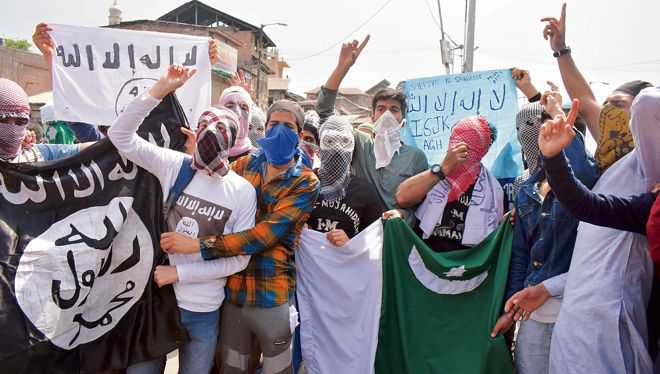
On guard: We need to be more alert in detecting ISJK’s attempts to fill in the vacuum in J&K due to the debilitation of the ISI-created conventional outfits.
Vappala Balachandran
Ex-special secretary, cabinet secretariat
Some sections of our security establishment were sceptical of a June 15 alert by Pakistan on the possibility of IED-vehicle attack(s) planned by an Al-Qaeda affiliate in J&K. An unnamed Indian security official was quoted saying that this could be interpreted as Pakistan’s attempts to absolve itself from blame if it happens. Although this had reportedly led to a high local alert, an IED attack did take place on June 17 on a security vehicle in Pulwama, injuring nine soldiers.
The notion that all militant groups on Pakistan soil are patronised by their government is erroneous. We should also remember that even hardened adversaries like Israel and PLO had cooperated in the past to face common enemies. In 1995, Yasser Arafat’s PLO secretly passed on to Mossad travel plans of Fathi Shkaki, leader of the pro-Iranian Palestinian Islamic Jihad. This led to his killing in Valletta (Malta) in October 1995. Shkaki had met Hussein Shaikholeslam, Iranian deputy intelligence chief, in Libya to discuss plans of assassinating Arafat as punishment for signing the 1993 Oslo accords with Israel.
Another incident was between the US and Russia even when their ties had nosedived. In 2017, President Putin thanked US President Trump for a CIA alert which helped them foil a major IS attack on the holy Kazan Cathedral in Saint Petersburg.
The reason for Pakistan’s worry is that the Al-Qaeda and IS are expanding their networks in Afghanistan and Pakistan due to the shifting loyalties within the Afghan Taliban consequent to their peace talks with Zalmay Khalilzad’s team. Their seventh round of talks is due at Doha this week. No progress could be made in May due to Taliban’s insistence that the US should announce a troop drawdown time table before a Taliban ceasefire. Marine Gen Frank McKenzie of US Central Command said last week that IS presence in eastern Afghanistan was worrying. The Taliban rejected this as justification of continued US military presence in Afghanistan. The US countered it saying that 300 airstrikes had to be done on IS strongholds since January 2017.
Gen McKenzie is supported by other experts like AP journalist Kathy Gannon and Bruce Hoffman of Georgetown University. Gannon said last week that the IS was a greater threat than the Taliban because of its sophisticated military capabilities. ‘Today it counts thousands of fighters, many from Central Asia but also from Arab countries, Chechnya, India and Bangladesh as well as ethnic Uighurs from China’. She said the recent wave of bombings in Kabul was ‘practice runs’ for bigger attacks in Europe and the US. The IS organised a suicide attack on May 30, 2019, at the entrance of Marshal Fahim National Defence University, killing six including cadets. Reports indicate that it is exporting talc, cromite and marble using smuggling routes to raise funds through its total control of Nangarhar.
The Combating Terrorism Center (CTC) at West Point has flagged IS threats to this region through a well-researched report in December 2018. The paper disabuses a common impression among some of us that the IS is incapable of storming into South Asia with liveries and cockades, as they did in Faluja or Mosul. That is not how it is operating in this region. Apart from its successful online radicalisation, it is able to get several defections. Although Abu Muhammad al-Adnani had made an announcement on Islamic State Wilayat Khorasan (ISK) in January 2015, it was preceded by defections by nine former local leaders of the Al-Qaeda in Afghanistan and six Tehrik-i-Taliban Pakistan (TTP) who joined them early in 2014. In 2016, they announced Kashmir as part of Wilayat Khorasan.
The secret of ISK’s success is the ‘high end’ or ‘low end’ cooperation from its allies in AF-Pak region. ISK was responsible for 211 attacks, resulting in 1,511 deaths in Afghanistan between January 2014 and July 2018. During the same period, it organised 83 attacks in Pakistan with 706 deaths. In April 2018, 10 journalists were killed in two attacks in Afghanistan. ISK carried out the second-deadliest attack in Pakistan’s history by bombing an election rally in Balochistan, killing 149 in July 2018.
The paper identifies 11 associates for the entire AF-Pak region. ‘High end’ partners are TTP’s Bajaur, Jundullah and Oraknazai factions, Islamic Movement of Uzbekistan, Ansar ul Khilafat Wal Jihad, Lashkar-e-Islam and Lashkar-e-Jhangvi (Al-Alami). The ‘low end’ are Ansar al-Mujahideen, Sipah-e-Sahaba Pakistan/Ahl-e-Sunnat Wal Jamaat, Jamaat-ul-Ahrar and Balochistan National Army.
The CTC’s analysis reveals that ISK’s total lethality and mortality per attack increased every year in Pakistan and Afghanistan. The biggest danger to the South Asian region is the lateral migration of extremists from older outfits like the Hizbul or Taliban towards the Al-Qaeda and IS. We cannot determine the identity of such groups by merely examining conventional markers. That was also the reason why our political leadership was often wrong on the impact of the IS in India. Our former Home Minister had said on March 16, 2018, that it would have no impact on India.
Fortunately, our NIA has dealt with this menace professionally and unearthed an IS-inspired module named Harkat-ul-Harb-e-Islam in December 2018. In May this year, it chargesheeted four IS in Jammu & Kashmir (ISJK) activists in Jammu. The NIA has also been following up connections between Sri Lanka’s Easter carnage and its South Indian modules.
At the same time, it is a moot question whether we have done enough to detect IS modules in India right from 2014 in the background of the current allegations that our southern modules had inspired the Easter Sunday bombers. We also need to be more alert in detecting ISJK’s attempts in filling in the vacuum in J&K due to the debilitation of the ISI-created conventional outfits.



























